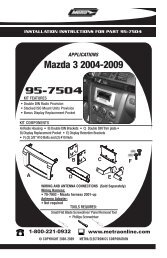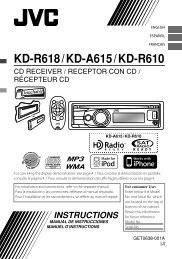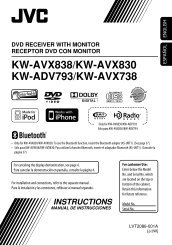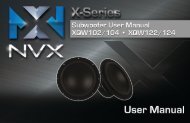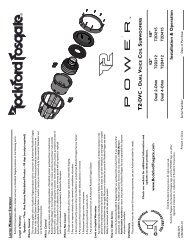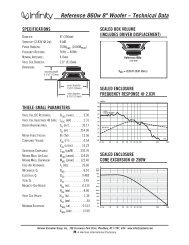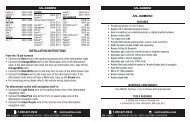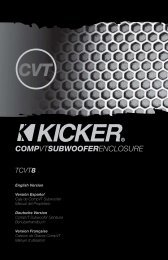2009 RS Multilingual f01.indd - Sonic Electronix
2009 RS Multilingual f01.indd - Sonic Electronix
2009 RS Multilingual f01.indd - Sonic Electronix
Create successful ePaper yourself
Turn your PDF publications into a flip-book with our unique Google optimized e-Paper software.
the narrow part of the front angle ring for the preferred angle of operation. Place the wire through the long<br />
mounting nut and loosely tighten the mounting nut around the tweeter. Rotate all the parts in unison until<br />
the tweeter is angled in the desired direction. Secure the assembly by tightening the mounting nut. See<br />
Fig. 5.<br />
For surface mounting applications use the surface mount cup as a template and pre-drill one 7/64”<br />
(2.5mm) screw hole (using two holes is optional) for attaching the surface mount cup to the panel and<br />
a 5/16” (8mm) hole for the wires. An M3 pan-cross head wood screw is supplied to attach the surface<br />
mount cup to the panel. Position the tweeter over the surface mount cup and screw it into position. See<br />
Fig. 6.<br />
CROSSOVER MOUNTING<br />
Mount the crossover in a location that is easy to access for wiring and tweeter output level adjustment.<br />
Make sure that the crossover will not be exposed to water. The bottom of the car door is not a good<br />
location. If you must mount the crossover in the car door, exercise caution as water can accumulate in the<br />
bottom of the door. Keep the crossover high in the door and shielded from water.<br />
tweeter mounting hole<br />
to tweeter<br />
lead wires<br />
woofer mounting hole<br />
<strong>RS</strong> crossover.<br />
(mounted inside<br />
door panel)<br />
to woofer<br />
terminals<br />
rubber<br />
grommets<br />
door jamb<br />
from amplifi er or<br />
source unit<br />
If factory speaker wiring is not available in your desired location, it may be necessary to run speaker wire<br />
through the door jamb. The speaker wire should be kept away from sharp edges and avoid the possibility<br />
of getting pinched by the door. An existing grommet in the door jamb is the ideal place to run the speaker<br />
wire. If the factory hole and grommet do not exist or are inaccessible, you must drill a hole to run the<br />
speaker wire through the door jamb. Be careful not to drill into other wiring or existing door mechanisms.<br />
Any time a wire is run through a hole, it is necessary to insert a rubber or plastic grommet to protect the<br />
wire from damage.<br />
9<br />
<strong>2009</strong> <strong>RS</strong> <strong>Multilingual</strong> <strong>f01.indd</strong> 9 11/21/2008 10:57:33 AM





